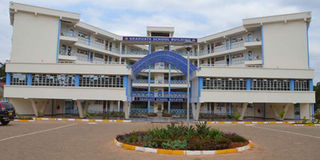Kenyatta University has built for the future

Some of the new buildings at the Kenyatta University. PHOTO | COURTESY
What you need to know:
- The university has gone from an artsy, social-cultural specialising institution, and is now bulking up on science and business, which is the direction in which the world is moving.
- Kenyatta University was always Kenya’s other university. The lead the University of Nairobi had over it, in numbers, alumni and resources, was nearly insurmountable. However, KU always had a card up its sleeve - it had land to expand.
- At the University of Nairobi, only student leaders say “comrade”. Others just scrawl it on walls or put it on posters. No one really says it. The word “comrade” is usually helpful in identifying people who have taken the university experience a bit too seriously.
Want to see Kenya’s property boom up close? Go to KU.
Kenyatta University has a massive gate, a gate large enough to be spotted on Google Earth.
It has multiple lanes, one of those gated community intercoms, those automatic arm-raising barriers you find in malls, and CCTV cameras.
The University says the gate is a dual carriageway, except that it narrows to a single carriageway 50 metres in.
Kenyatta University was always Kenya’s other university. The lead the University of Nairobi had over it, in numbers, alumni and resources, was nearly insurmountable. However, KU always had a card up its sleeve - it had land to expand.
And so it did.
Kenyatta University has been cranking up the mortars - it has a mall called Unicity, a business school, an alum centre, a morgue and a health centre. All newish. It also has a massive central administration centre, though I must say that even the politburo would have been slightly embarrassed at the thing - you could fit in some of the science labs in the school in the building. I was, therefore, surprised that several lecture theatres are too small to accommodate all the students - there was standing room only in one lecture hall I walked past. If you have been here, then you know the main campus is huge; it even has a shuttle service with one of those low-slung buses, which is a delightful touch.
MODERN LIBRARY
The uni also has a bell tower – without a bell. A bell tower is useless in the era of megaphones. Bells toll for no one. Every student I asked did not know what the bell tower was for or what it is. One girl called McKenna – she spells it that way by the way - said it could serve as a watchtower. Against what? “It will be a rally point in case of disaster,” she said quietly, reminding me of the new fears that stalk university students.
Kenyatta University has a cavernous modern library which looks large enough to hold its entire population on exam week. It is also well stocked, the perfect place to do some serious reading.
The most rundown buildings are, as you would expect, to be found in the arts department. The more easily commoditised your subject, the easier it is to measure what is done there on a standardised test, then the better the building you get.
It probably has something to do with the fact that KU has gone from an artsy, social-cultural specialising institution and is now bulking up on science and business. The university gospel is now about science and entrepreneurism, and KU are big believers.
The university has a private lift for the senior management, and also a dedicated service to shuttle students with disabilities across the massive campus. It also has solar-powered streetlights and a petrol station. Clearly, the institution cares about the environment and optics, but is also in tune with practical realities and old habits.
There is also an amphitheatre. George, a student of commerce, told me that he had never been to the amphitheatre, but “Comrades go there every weekend.” At the University of Nairobi, only student leaders say “comrade”. Others just scrawl it on walls or put it on posters. No one really says it. The word “comrade” is usually helpful in identifying people who have taken the university experience a bit too seriously.
Impressive buildings but…
This university serves as a cautionary tale. If you keep slashing higher education budgets and push them into the free market, you end up with trophy architecture to attract students. The new buildings are great — there was an infrastructure deficit — but were a Brandenburg Gate and an Italian bell tower necessary?
The school is gripped with an edifice-complex that is set to continue even as its accommodation problem persists.
What if some of this money were directed to the professors, lecturers and the students’ accommodation? Wouldn’t the university be much better?
When all is said and done, though, KU looks great, and it probably is a better university now than UoN. It could build out and wide. UoN main campus could only go up, and its tower now casts a shadow over the campus.
KU has built for the future.





